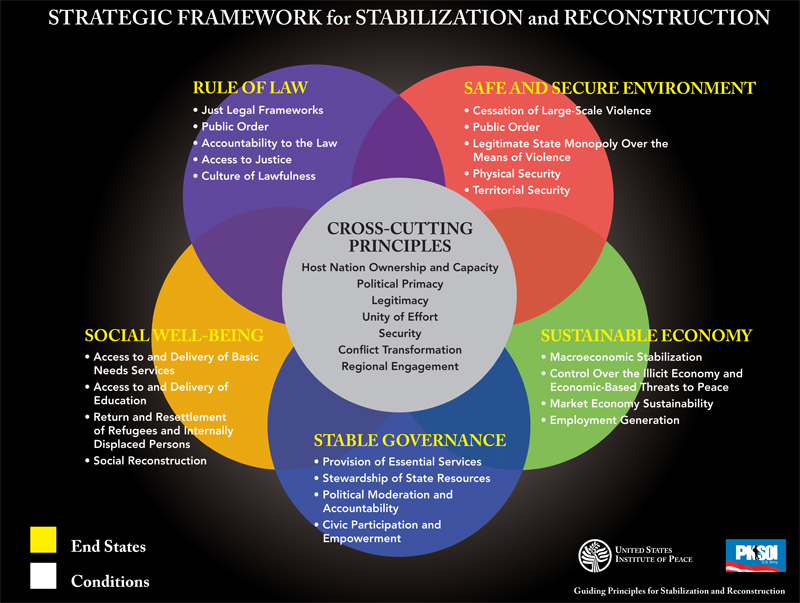Guiding Principles for Stabilization and Reconstruction: Strategic Framework for Stabilization and Reconstruction
Published November 2009
Section 2
2.0 The Strategic Framework for Stabilization and Reconstruction
The Strategic Framework for Stabilization and Reconstruction offers a comprehensive look at the complexity of these missions. Based on a comprehensive review of guidance, it provides a foundation from which to determine priorities with and based on the needs of the host nation. The framework below depicts the major end states, as well as the necessary conditions that should be established to achieve those end states. The framework also elevates a set of cross-cutting principles that applies to each and every actor and impacts each end state. This framework recognizes that the end states and their associated conditions cannot be pursued independently of one another. The overlapping circles underscore this interdependence.18
2.1 End States
Below is a summary description of each end state, framed according to the perception of the host nation population, as they will be the final arbiters of whether peace has been achieved.19
- Safe and Secure Environment. Ability of the people to conduct their daily lives without fear of systematic or large-scale violence.
- Rule of Law. Ability of the people to have equal access to just laws and a trusted system of justice that holds all persons accountable, protects their human rights and ensures their safety and security.
- Stable Governance. Ability of the people to share, access or compete for power through nonviolent political processes and to enjoy the collective benefits and services of the state.
- Sustainable Economy. Ability of the people to pursue opportunities for livelihoods within a system of economic governance bound by law.
- Social Well-Being. Ability of the people to be free from want of basic needs and to coexist peacefully in communities with opportunities for advancement.
2.2 Cross-Cutting Principles
The following are high-level principles that should be applied by every person and to every activity that is conducted in support of the S&R mission. The division of labor into five core end states helps to focus and standardize actions based on decades of experience. But this division also neglects the big picture—the overarching guidance that cuts across every end state and affects every action of every individual:
- Host Nation Ownership and Capacity
- Political Primacy
- Legitimacy
- Unity of Effort
- Security
- Conflict Transformation
- Regional Engagement
2.3 Structure of the Manual
The manual is structured according to the framework. Cross-cutting principles are presented in Section 3. Each end state corresponds with a dedicated section in the body of this manual. Each section includes descriptions for the necessary conditions, and the major approaches that have been used to establish those conditions based on decades of experience. Relevant trade-offs, gaps, and challenges20 are also addressed at the end of each section.
